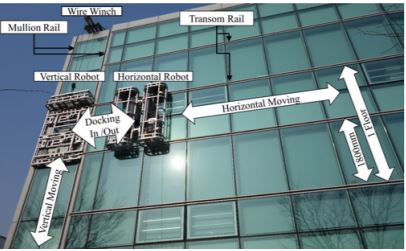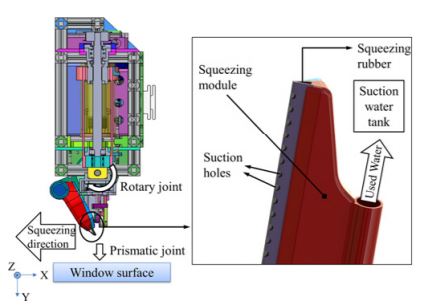Window cleaning system with water circulation for building façade maintenance robot and its efficiency analysis
Due to the increased usage of glass for the facades of contemporary high-rise buildings, periodic maintenance is required, especially window cleaning. Conventional maintenance usually relies on human laborers and a gondola that is suspended by a cable-driven system. However, these methods require experienced laborers, are inherently dangerous, and sometimes cause emergency situations when wind gust or earthquakes occur. For these reasons, many studies have been conducted on the subject of automating window cleaning work of high-rise buildings. Since the building walls are always vertical and are in the direction of gravity, the ability of locomotion on the vertical surface has been an important issue for automated window cleaning systems. This resulted in a lot of studies regarding the moving mechanism of these systems, such as magnetic force, suction force, suspended cable, guide rail built-in the building wall facade, and biomimetic adhesion force. However, the issues of material handling and cleaning method that are also particularly important have not been addressed in a systematic as well as scientific way. The roll-brush method, often used in the conventional systems, has an advantage on cleaning efficiency but requires large amount of water. This excessive use of water causes additional environmental pollution due to scattering and dripping of contaminated water in the surrounding area.
In this paper, a new cleaning tool system is developed to improve the cleaning efficiency. In particular, this system uses fine mist water spray by two-phase injection nozzles and Pulse Width Modulation (PWM) flow control. The water usage is further minimized by using a water circulation system (injection-squeeze-suction-collection-filtering-recharge) instead of simple water injection and cleaning. These methods greatly reduce environmental pollution due to the dripping and scattering of contaminated water. In addition, the proposed tool system was verified through experimental tests and statistical analysis of their results, in which the amount of water usage and cleaning efficiency was measured and compared with existing cleaning methods.
Building Façade Maintenance Robot (BFMR) considered in this paper consists of both horizontal and vertical robots. The horizontal robot carries out window cleaning work while moving along a horizontal (transom) rail. The vertical robot transports the horizontal one to another up/down level along a vertical (mullion) rail. After cleaning a horizontal floor, the horizontal robot docks into the vertical one by means of little rail extenders of the vertical robot. The vertical robot is securely held in place with rail breaks when the docking takes place. Then, the vertical robot is transported up or down by a wire winch. Afterwards, the horizontal robot can clean the next floor. The horizontal robot consists of two parts that are linked together with hinges so that even curved facades can be cleaned. The horizontal robot is also equipped with tool docking devices so that it is also possible to store other maintenance tools.
The window cleaning process consists of four consecutive steps: water spraying, squeezing, suctioning, and recycling. Accordingly, the tool system has four different modules corresponding to the steps. The squeezing module is made to ensure continual contact to the glass with a consistent contact angle between the squeezing rubber blade and the glass surface by means of two active joints. The suction module is coupled with the squeezing module by placing the suction holes right behind the squeezing blade so that water can be retrieved right after squeezing without dripping. The water spray module has four injection nozzles so that the water can be sprayed on the entire vertical area at once. In order to reduce the excessive water usage in the cleaning operation, a PWM flow control was applied to the injection nozzles. To prevent the scattering of water into the air, the injection control unit is able to adjust the amount of water injected to the movement speed and position of the horizontal robot. This way, the water is uniformly distributed on the window surface. The water from a water tank is first mixed with compressed air from an air tank before it is sprayed out in a fine mist form. This also ensures that less water is used. Used water that is recovered by the suction system is first added to a suction water tank, then filtered when a certain level in this tank is reached and then again added to the main water tank. Each part of the cleaning tool system consists of an independent control board and communicates with each other through CAN protocol for integrated control.
The water usage and efficiency of the existing cleaning methods, thus human labour and existing automated building cleaning systems, and the BFMR system was analysed. After analysis, it turned out that the BFMR system without the water circulation system (WCS) uses meaningfully less water as human labourers. Furthermore, The statistical comparison for both the BFMR with and without WCS showed that the water consumption is reduced by about 20% with the water circulation method. this certainly helps to increase cleaning area with one loading of water on the robot, which greatly affects the design of a compact and light-weight robot. Additionally, the new cleaning tool together with the building façade maintenance robot certainly reduces water usage compared to conventional automated building cleaning machines.

